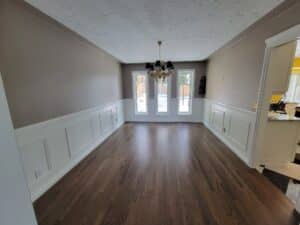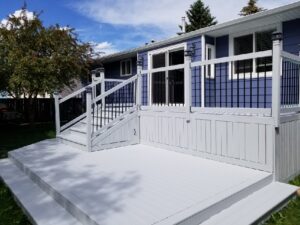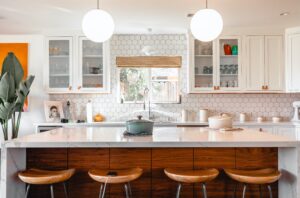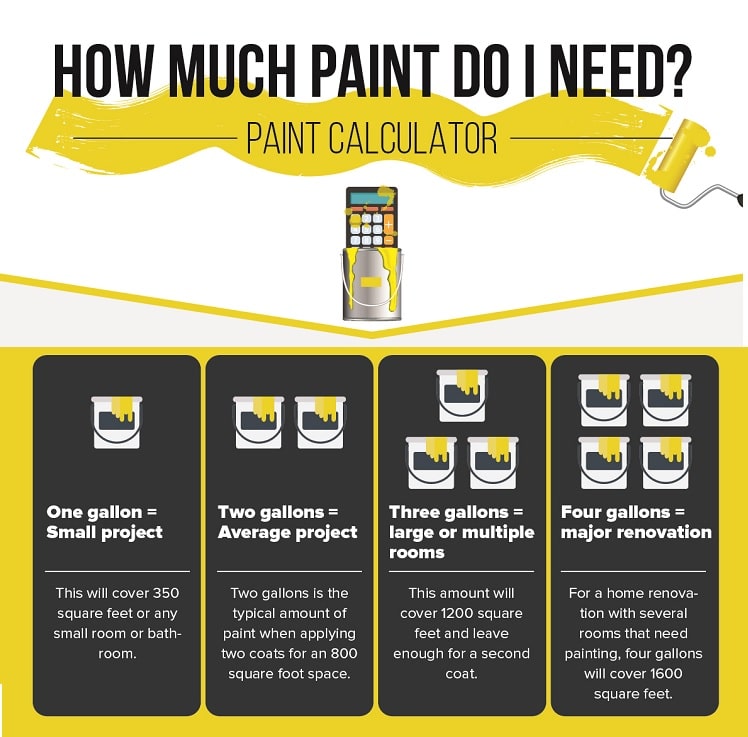
If you’re looking for the most cost-effective way to renovate or update your home, painting is the answer. A new colour or just a touch-up can completely transform and renew a tired and worn looking house. Painting is also a great DIY project, but before you buy any paint, have you asked yourself or wondered, “how much paint do I need?” Depending on the size of the project, the answer can easily vary.
Some quick math or using a paint calculator will help give an answer and save making more than one trip to the store. But first, other considerations may affect those calculations. So, before you start, here are a few additional factors to take into account.
Table of Contents
ToggleThe role of surfaces
Depending on what type of surface you are painting, and whether interior or exterior, this will affect how much paint you need. Some surfaces are extremely porous and will absorb more paint and so need more layers. That is most likely to occur on exterior surfaces, as certain types of siding are more porous. For the interior, needing one or two coats of paint will depend on the new colour and type of old paint being covered.
Exterior textures
As a general rule, exterior surfaces will always need two coats of paint. Depending on the type of surface, an initial layer of primer may also be necessary. The primer will seal the surface against future stains, help the new paint adhere better, and increase its durability. Adding two layers of paint on top will further enhance the paint’s durability and help it withstand the elements. With three layers, your exterior paint job will last twice as long and continue to look just as good.
Rougher and so more porous exterior surfaces will need a more generous application of paint when applying the two coats. These rougher surfaces include shake and shingle siding, stucco, and brick. One gallon of paint typically covers 350-400 square feet, but will only cover 300 to 350 square feet of a porous surface. When figuring out how much does a gallon of paint cover, make sure you keep the surface texture in mind.
Interior textures
Interior paint is dependent on both the surface and type of pre-existing paint. Wallpaper (yes, you can paint over wallpaper!) will need a fast-drying primer to ensure the first coat of paint isn’t absorbed into the wallpaper instead. If it does, you’ll end up with a peeling mess and wasted time and money. When changing paint types, such as gloss to flat, a primer needs to be applied first. That will help the new paint layer adhere properly to the wall and ensure a smoother, professional-looking finish.
Colour change
Either matching old colours or choosing a new shade will also affect the answer to, how much paint do I need. If you match old colours for a simple touch-up, one layer of paint is enough. Even when painting over with a similar shade, you may be able to get away with one coat. Painting light over dark, though, will be a different matter. Light paint over a dark surface will require much more paint and primer to cover it completely. A good pro tip is first to apply one or two layers of white or grey-tinted primer. That helps create a neutral base so that the new lighter paint will easily cover the dark. Wait for each layer to dry before checking to see if the dark layer is still visible, and apply a third coat if needed.
Dark over light is much easier and will typically require much less paint to accomplish. Using a primer is also more optional, as the dark paint will easily cover the lighter base. Still, plan to use two layers of paint to ensure that the finish is smooth and even.
Paint factors that affect the amount
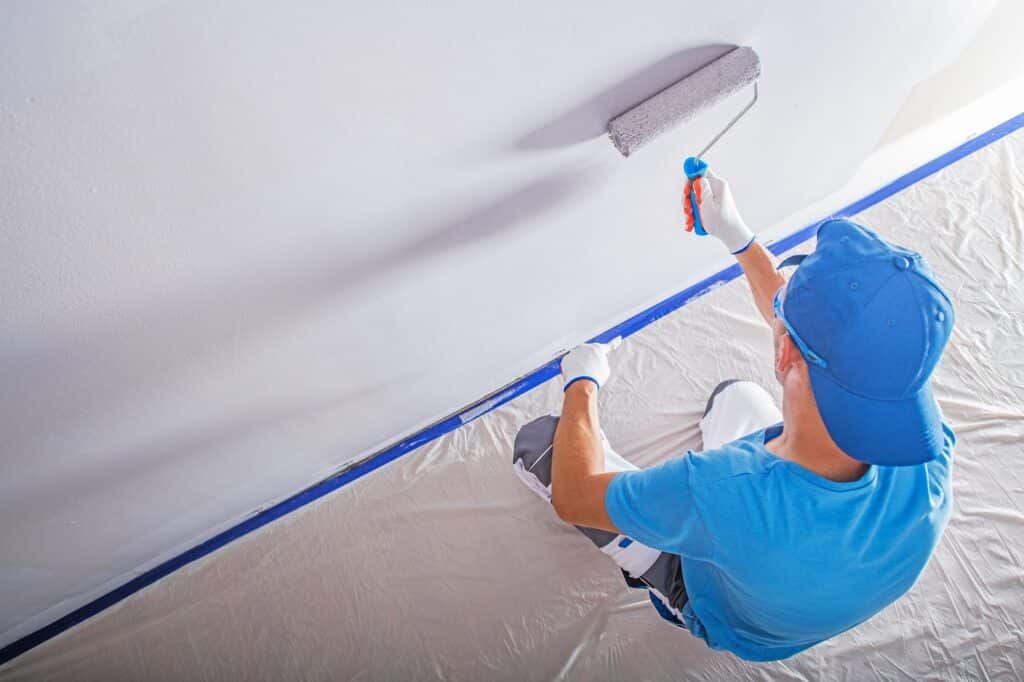
In addition to wall surfaces and colour choice, the type of paint itself will affect how much you need. That will include both the quality of the paint as well as when else to use a primer.
Quality of paint and using primer
High-gloss vs low-gloss and high- or low-quality paint, will all have different impacts on how many coats you’ll need. While lower-quality paint may be cheaper, it’s not a cost-effective purchase over the long run. There is less resin in low-quality paints, so once dry, the paint is thinner and less durable. You’ll spend more money and need more applications to achieve the same quality look from a better paint.
Before painting, check to see whether the old paint is a high- or low-gloss. High-gloss paint is extremely durable and is best for cabinets, high-traffic areas, and trim. However, it is also resistant to new paints and must be prepared and primed first. Knowing this will help save multiple trips to the store for new paint and prevent wasting time.
Calculating how much does a gallon of paint cover should also include the same for primer. Many surfaces or types of paint will need an initial layer of primer to ensure the new paint adheres to the surface. If you are DIYing a paint project, you should ask your paint supplier for advice on using primer or not. Primers help seal surfaces, create adhesion, cover stains, and ensure a smooth and even finish. It may be tempting to skip to save some expense, but your paint job will suffer in the long-run.
When to prime
Drywall: Drywall, especially when new, is extremely porous and will benefit from an initial primer. That will also save using excess paint trying to evenly coat the new wall without any primer. You can get away without using primer, but it will require more coats for a smooth finish.
Over any repairs: If you have any cracks or scuffs, always repair those first. Once they are, use a little bit of primer on the repaired spot before painting. In touch up jobs like these, you can get away with a smaller purchase of primer.
Dark to light: As mentioned before, priming dark paint will make it much easier to transition to a light colour. Even a tinted primer can help cover the dark colour and make the light colour easier to apply.
Wallpaper: Unless primed, the paint will soak into the wallpaper and loosen it from the wall. Instead of a beautiful finish, you’ll find your wallpaper peeling free and leaving a mess.
When not to prime
No stains or damage: If your walls are still in good condition, don’t worry about priming. Without any risk of marks showing through, you can just apply the new paint.
Using similar colours: If the new colour is a similar enough shade, you won’t need a primer. Two layers of new paint will be enough to cover the old colour.
All-in-one paint: There are self-priming paints that you can buy that act as both primer and paint. These are only recommended if the walls are in good condition; otherwise, a separate purchase is best.
Paint rule of thumb
Generally, you will use about 1 gallon of paint for every 350 square feet of surface you want to paint.
In addition to using a paint calculator, there is a general rule of thumb when purchasing paint. Once you know the total amount needed, add 10% to that number. That way, you have some elbow room for any mistakes or any paint that dries in the tray before you use it. With that in mind, here is another guideline to know how much does a gallon of paint cover:
One gallon = small project: This will cover 350 square feet or any small room or bathroom.
Two gallons = average project: Two gallons is the typical amount of paint when applying two coats for an 800 square foot space.
Three gallons = large or multiple rooms: If you have plans to paint either one large room, any adjoining rooms, or a ceiling, go for three cans. This amount will cover 1200 square feet and leave enough for a second coat.
Four gallons = major renovation: For a home renovation with several rooms that need painting, four gallons will cover 1600 square feet.
Keep in mind that surface texture, colour transition, and paint quality will affect the final amount of paint needed. For a more accurate calculation, use this calculator to find out exactly how much you need.
Paint calculator: how much paint do I need?
To determine the paintable surface area, you’ll have to do some simple math. First, measure the length of the walls and the height of the walls. Then add together all the lengths of each wall in the room and multiply that number by the height of the room. Make sure you measure from the floor to the ceiling to get the height. The number you get is the square footage of the area you want to paint.
If there are doors and windows, you will have to adjust your math a little. On average, you can subtract 15 square feet for each window in the room and 20 square feet for each door. If the window is larger than average, subtract an extra 5 square feet. That will give you a number close to the total surface area you will have to paint.
Painting calculation specifics

When painting windows and trim, the calculations will likely vary for each home. The paint calculator applies a standard measurement of an average door being 20 square feet and an average window measuring 15 square feet. Still, doing a little extra math won’t hurt, especially if your home has custom-shaped windows or different trim.
Primer
Primer covers slightly less than paint, with one gallon covering 200-300 square feet. When calculating primer, follow the same steps, multiplying the total length x width of the room. But then, divide that answer by 300 instead, for the total amount needed for one coat of primer.
Windows
The amount of paint needed for windows will depend on the shutters, any trim, and the size of the frame. Most paint calculators eliminate the window as a whole from any wall surface estimates. To calculate the trim, add the total length and total width of each window. Then multiply length x width and divide by 350 for the total amount. With most trim, one quart of trim paint will typically be enough.
Doors
Most doors follow a standard measurement of 20 square feet, which is a safe number to use. If your door has custom additions such as sidelites or windows, take the time to do your own measurements. Then, divide the total by 350 for the total amount of paint needed. If you plan to paint both sides of the double, don’t forget to double the sum total.
Trim
Typically, trim ends up needing less than a gallon of paint to cover any trim in a standard size room. To calculate, add the length of all the trim in the room and do the same for the width. Then, multiply the total length x width for the total square footage. Divide by 350 for the total amount needed for one coat.
DIY or pro?
Paint is something that can be either done as a DIY project or left to the professionals. There is no right or wrong choice, as both are beneficial and come down to a matter of personal preference. There are a few factors, though, that can help with the final decision.
DIY
The main reason homeowners DIY is to help save some expenses when it comes to painting. You will still have to buy the tools and paint, but you save on the labour costs. If you are touching up old paint or plan to paint one room or some kitchen cabinets, there’s no reason not to DIY. Otherwise, you can’t go wrong with hiring a professional.
Professional painting
Professional painters know the ins and outs of what paints to choose, the best colours, and even application techniques. Not only that, but they help save time by handling the work for you and finishing in less time. If you’re planning to sell your home, or have a major painting renovation planned, leave it to the pros. They’ll guarantee that the paint job not only lasts but adds value to your home. Any design tips or ideas as well can be discussed with a professional painter. Plus, they’ll do the calculations themselves to determine how much paint is required for your project.


